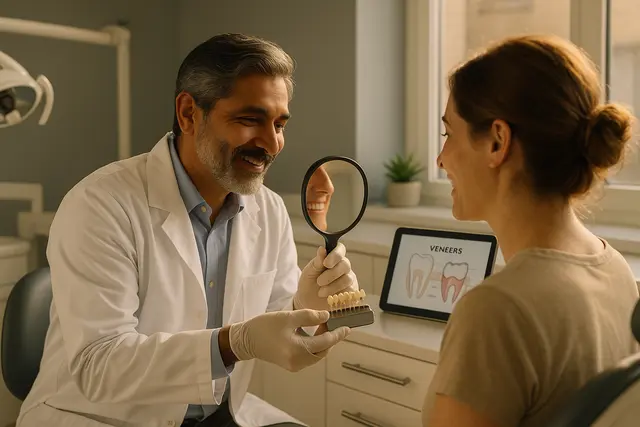Cosmetic Dentistry
7 min read
Mar 16, 2025
Bonding Veneers Cost
Dental bonding and veneers improve the appearance of teeth by fixing chips, gaps, discoloration, and minor misalignment. Both treatments can enhance a smile, but costs vary depending on materials, procedure complexity, and location.

Why You Should Care About Dental Bonding and Veneers Prices
Your smile sits front and center in every selfie, job interview, and first date. When cracks, stains, or gaps start hogging the spotlight, many people visit a dentist for a cosmetic fix. Two of the most popular options, dental bonding and porcelain veneers, can look similar in Instagram photos, yet the bill you hand to the receptionist can be worlds apart. Let’s explore how each cosmetic dental procedure works, what it costs, and which path makes sense for your budget, lifestyle, and dental health.
What to Expect During a Typical Dental Bonding Appointment
Dental bonding is a cosmetic dental procedure that uses composite resin material to reshape or recolor teeth. After the dentist roughens the surface of the tooth, a bonding agent is brushed on. Soft composite resin ,tinted to match the color of your natural teeth, is layered, shaped, and cured with a bright light.
Because the dental bonding procedure keeps most enamel intact and wraps up in one dental visit, it’s a favorite for quick fixes. Bonding is a great option if you chipped a tooth on movie‑theater popcorn or want to fill in gaps between teeth without braces.
Porcelain Veneers: Why These Thin Shells Command a Higher Price
Veneers are thin, custom‑made shells, usually crafted from dental porcelain, that cement to the front of natural teeth. Your dentist removes a sliver of enamel, takes impressions, and sends them to a lab. You’ll sport temporary veneers for a week or two while the permanent ones are sculpted.
Veneers are more durable than composite bonding, shrug off coffee stains, and can last well over a decade with excellent dental care. The drawback? Veneers typically range from $900 to $2,500 per tooth, making them a premium cosmetic procedure.
Tooth Bonding: Small Repairs With Big Impact
Tooth bonding shines when you need a single spot repaired, say, a stubborn white spot after braces or a minor overlap. The bonding resin can be feathered so precisely that it blends into the surface of the tooth. Bonding typically takes 30 to 60 minutes per tooth. Because the initial cost is low and the procedure is painless, patients often choose bonding first, then upgrade to veneers later if they crave a Hollywood grin.
Cosmetic Goals: Matching Your Smile Wish List to Reality
Every cosmetic dentistry journey starts with one simple question: “What do I actually want to change?” If you fret over one chipped incisor, the bonding process is perfect. If you dream of totally uniform teeth and ultra‑bright shade, veneers could suit you better. Remember, bonding is a cosmetic dental fix for minor dental issues; veneers are a long‑term investment in a perfectly symmetrical smile.
Breaking Down the Average Cost of Dental Bonding
So, how much does dental bonding cost? Nationwide data show bonding typically ranges from $200 to $600 per tooth. That figure can leap to $800 in high‑rent cities or drop below $150 in small towns. The cost of dental bonding stays low because there’s no lab fee, and materials are inexpensive compared to porcelain. Still, the skill of the cosmetic dentist and the complexity of the bonding work influence the final invoice.
Real‑World Numbers: Much Does Dental Bonding Cost?
Imagine you chipped one front tooth while snowboarding. In a suburban clinic, your final bonding cost might be $300. Add three more teeth for a full contouring session, and the total jumps to roughly $1,200. Compare that to veneers, where four porcelain shells could cost anywhere from $4,000 to $8,000. The cost difference is why many patients start with bonding.
Bonding Versus Veneers: A Dollar‑for‑Dollar Comparison
Bonding vs veneers isn’t only about price. Bonding typically lasts four to seven years; veneers can last ten to fifteen. Veneers resist red‑wine stains, while composite resin may discolor by year three. Bonding is a cost‑effective solution for college students, young professionals, and parents funding braces for their kids. Veneers are more expensive but deliver a showroom smile that rarely chips.
Key Factors Affecting the Cost of Your Procedure
Several factors affecting the cost can nudge your estimate up or down:
Number of teeth that need work, the more teeth, the higher the bill
Type of veneers (porcelain, composite veneers, or ultra‑thin variants)
Geographic region, New York prices dwarf rural rates
Experience of the cosmetic dentist, artistry costs money
Add‑ons such as teeth whitening or protective night guards
Follow‑up care, regular dental visits keep everything polished and secure
Hallmarks of High‑Quality Bonding Work
Great bonding work is invisible. The shade matches the color of your natural teeth, the edges feel smooth to your tongue, and no one can spot the join line. Always ask your dentist to show a smile gallery of previous bonding and veneers cases. Seeing real patient photos builds trust and ensures you’ll love your own results.
Counting the Cost Per Tooth for a Total Smile Makeover
When patients ask for a full redesign, dentists calculate the cost per tooth and then multiply. If eight teeth need to be bonded, even a modest $250 rate balloons to $2,000. Veneers could quadruple that amount. Always clarify how many teeth need to be bonded or veneered so you aren’t shocked at checkout.
Daily Dentistry Habits That Protect Your Investment
Bonding depends heavily on solid home care. Use a soft toothbrush, non‑abrasive toothpaste, and floss daily to prevent staining at the margins. Skip pen‑chewing, ice‑crunching, and nail‑biting, habits that crack composite resin. Regular dental visits every six months let your dentist polish the surface of the tooth and extend the lifespan of bonding.
Cost of Dental Bonding Versus Other Cosmetic Procedures
Compared to other cosmetic dental fixes, crowns, braces, or clear aligners, bonding is a steal. Crowns cost anywhere from $1,000 to $2,000, while orthodontic work often tops $5,000. The cost is far lower for bonding, yet the improvement in the appearance of your teeth can be dramatic.
Composite Veneers: The Mid‑Range Alternative
Composite veneers bridge the gap between bonding and porcelain. Sculpted chairside in one appointment, they cover the full surface of the tooth like porcelain but at half the price, roughly $400 to $800 each. Composite veneers cost more than bonding yet stain faster than porcelain, so weigh longevity against your budget.
Will Dental Insurance Cover Any of This?
Most dental insurance plans label bonding and veneers elective, meaning they rarely cover the cost. If the bonding procedure repairs chips from an accident, some carriers help. Flexible spending accounts and health savings accounts can also soften the blow. Always check first so you know whether you’ll pay in full.
Keeping Teeth and Gums Healthy After Bonding
Bonding is a cosmetic dental procedure, not a cure for decay or gum disease. Your dentist will insist on treating cavities and inflamed gums before touching cosmetic bonding. Healthy teeth and gums form the foundation that lets bonding last and veneers shine.
How Long Does Bonding Last, and Can You Stretch It?
Bonding typically lasts four to seven years, but lifestyle counts. Coffee, tea, curry, and red wine stain resin. Smokers may see discoloration in two years. Using a straw, rinsing after dark drinks, and wearing a night guard if you grind can stretch bonding last timelines toward that seven‑year mark.
When Veneers Win the Durability Debate
If you’re on camera daily, veneers vs bonding is often an easy choice. Veneers are more durable, shrug off stains, and stay glossy year after year. While the initial cost is steep, veneers are custom‑made, ultra‑precise, and can save you return trips to the dental chair.
Dental Bonding vs Other Fixes Like Crowns or Braces
Bonding is a cosmetic dental lifesaver for tiny flaws. Crowns act like helmets for weak teeth; braces shift the entire bite. Teeth bonding vs orthodontic treatment comes down to speed and scope. Bonding is a sprint, orthodontics a marathon. Consider dental bonding if you need a quick lift instead of long‑term tooth movement.
Composite Veneers Cost and Value Recap
Composite veneers cost half of porcelain, wear better than bonding, and require less enamel removal. They give you a uniform color fast, yet they still stain over time. Ask your dentist to compare composite bonding, composite veneers, and porcelain so you see where your priorities land on the cost‑durability spectrum.
Urban vs Rural: How Location Impacts Dental Bonding Costs
City practices pay higher rent, offer fancy coffee, and charge more. Rural clinics spend less on overhead, so bonding typically costs anywhere from 20 to 40 percent less. If you live near state lines, shopping around can save substantial cash without sacrificing quality.
How Much Is Dental Bonding Worth to Your Confidence?
The bonding cost per tooth may feel hefty, but the emotional payoff is real. Many patients report smiling wider in photos, speaking up in meetings, and ditching hand‑over‑mouth laughs. When you weigh that daily confidence boost against a one‑time fee, the math often favors going ahead.
Still Not Sure? When You Should Seriously Consider Dental Bonding
If your budget is tight, your schedule busier, or your dental issues minor, bonding is a cost‑effective way to repair chips, fill gaps, and brighten shade. Done well, dental bonding costs a fraction of veneers, looks natural, and can be upgraded later. Talk with a trusted dentist, review your smile goals, and decide whether bonding fits. Either way, your next grin could be the most confident one you’ve shared yet.
What Is the Main Difference Between Dental Bonding and Porcelain Veneers?
Dental bonding uses a tooth-colored resin applied directly to teeth for quick fixes like chips or gaps, usually in one visit. Porcelain veneers are custom-made shells that cover the front of teeth for a longer-lasting, more dramatic result. Veneers cost more but offer superior stain resistance and durability.
How Much Does Dental Bonding Typically Cost Per Tooth?
Dental bonding usually costs between $200 and $600 per tooth, depending on your location, the complexity of the fix, and your dentist’s experience. It's one of the most affordable cosmetic dental procedures, especially compared to porcelain veneers, which can cost $900 to $2,500 per tooth.
How Long Does Dental Bonding Last Compared to Veneers?
Dental bonding typically lasts 4 to 7 years with proper care, while porcelain veneers can last 10 to 15 years or more. Bonding is more prone to staining and chipping, but it’s also easier and less costly to repair or replace.
Is Dental Bonding Covered by Insurance?
Most dental insurance plans consider bonding cosmetic and don’t cover it. However, if the bonding is done to repair damage from an injury or accident, partial coverage may apply. It’s best to check with your provider and explore options like flexible spending or health savings accounts.
Read Next
Related Posts

Cosmetic Dentistry
Looking for a Dentist Who Whitens Teeth? Here’s What to Know First
A brighter smile can do wonders for your confidence, but finding the right dentist who whitens teeth takes more than just a quick Google search. From treatment options to experience and safety measures, there are a few key things you should know before booking that whitening appointment.
3 min read
Sep 10, 2025

Cosmetic Dentistry
What Type of Dentist Does Veneers? Here’s Who to Trust With Your Teeth
Dreaming of a flawless, photo-ready smile? Veneers can be a game-changer, but only if you choose the right expert to apply them. Understanding who’s qualified to handle this cosmetic procedure is key to getting results that look natural and last for years.
5 min read
Sep 08, 2025

Cosmetic Dentistry
Cosmetic Dentistry and Implants: How They Work Together
A confident smile can do wonders for your self-esteem, and modern dentistry offers more ways than ever to achieve it. Whether you're dealing with missing teeth or simply want a brighter, more balanced look, cosmetic dentistry and dental implants provide powerful solutions that work hand-in-hand to restore both function and aesthetics.
5 min read
Sep 05, 2025
Don’t have time to research every dentist around you?
See why 30k+ patients trusted us